Gentle movement can transform your stress and worry into a sense of calm. You'll find relief through simple stretches that target tense areas like your neck and shoulders, along with mindful floor exercises such as child's pose and reclined twists. Try incorporating slow, controlled breathing while you move to activate your body's natural relaxation response. Morning yoga flows, peaceful walking meditations, and balance exercises like tree pose help quiet racing thoughts. Even brief sessions of chair-based movements or hand and wrist stretches can ease daily tension. Discover how these accessible practices can become your daily refuge from stress.
Simple Stretching for Inner Peace
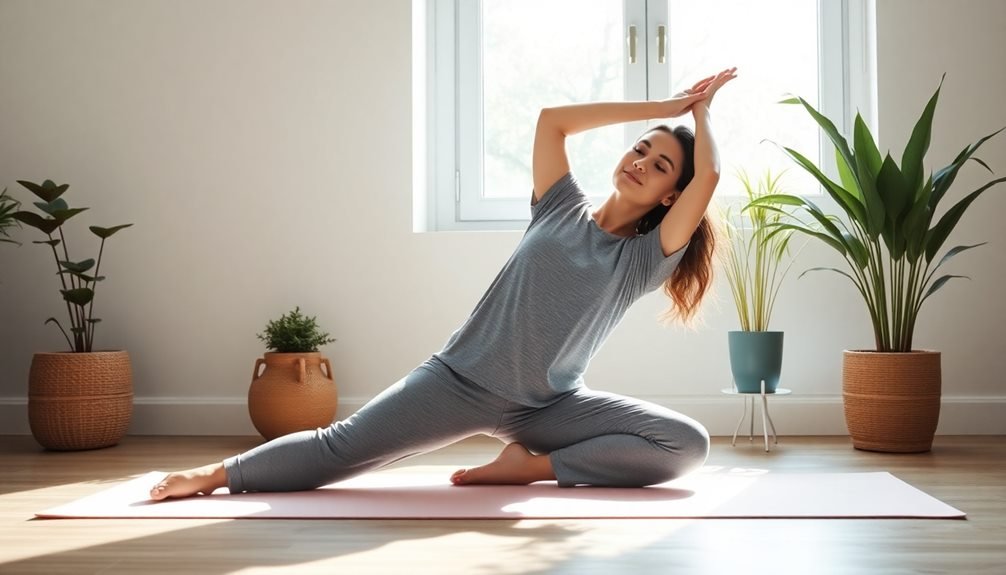
With a gentle approach to movement, stretching can become your daily refuge from stress.
You'll find that slow, mindful stretches help release physical tension while calming your racing thoughts. Start by finding a quiet space where you can focus on your breath and body sensations.
Begin with your neck and shoulders, areas where most people carry stress. Slowly roll your shoulders backward and forward, then gently tilt your head from side to side. Let each stretch last for 15-20 seconds.
Move down to your spine by performing seated twists and forward folds, being careful not to force any movements.
Focus on your lower body by stretching your hamstrings and hip flexors. You can do this while lying on your back or sitting on the floor. Try a simple figure-four stretch to release tight hips, or extend your legs forward for a gentle hamstring stretch.
Remember to breathe deeply throughout each movement.
Don't rush these stretches – they're most effective when performed slowly and mindfully. If you feel any pain, ease off immediately.
You'll notice that regular stretching not only loosens tight muscles but also provides a meditative experience that helps clear your mind.
Mindful Walking Around Your Space
Transform your daily walks around your home into moments of mindful movement and stress relief. Start by choosing a quiet path through your living space, whether it's circling your kitchen island, walking down your hallway, or moving between rooms.
As you walk, focus on each deliberate step, feeling your heel touch down first, then rolling through to your toes. Notice how your breathing naturally syncs with your movement. Keep your pace slow and steady, allowing your arms to swing gently at your sides.
Pay attention to the different textures beneath your feet – the softness of carpet, the coolness of tile, or the firmness of hardwood. You don't need a large space; even a small apartment offers enough room for mindful walking.
If your mind wanders, gently bring your attention back to your footsteps and breathing. Try incorporating short phrases with each step, such as "peace" as you step forward with your left foot and "calm" with your right.
Practice this mindful walking for five to ten minutes, gradually increasing the duration as you become more comfortable with the practice.
Gentle Morning Yoga Flow
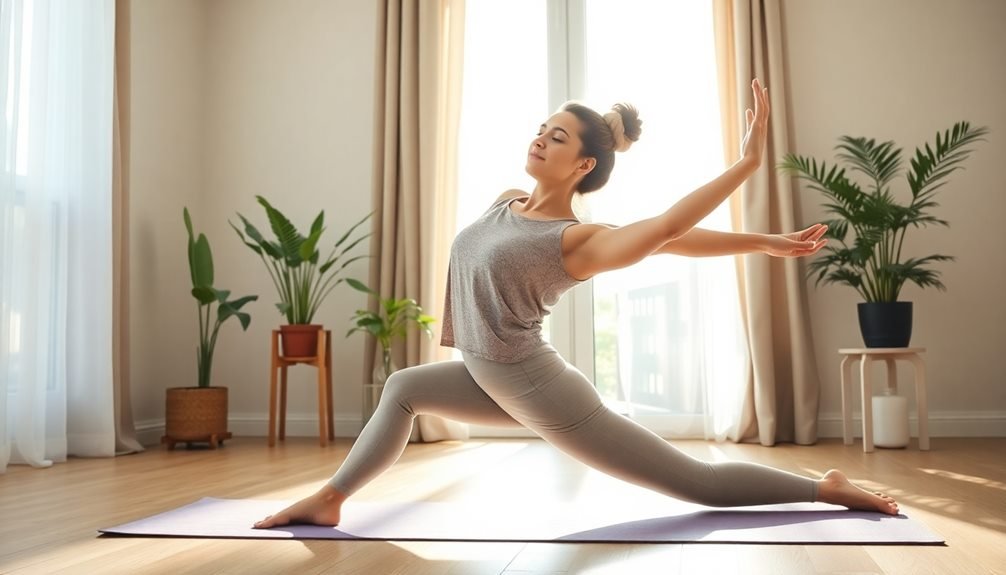
Your morning yoga practice can begin with a basic stretch sequence that includes gentle neck rolls, shoulder rotations, and spinal twists while seated on your mat.
You'll then move into energizing Sun Salutations, flowing through poses like Mountain, Forward Fold, and Plank to wake up your entire body.
Basic Morning Stretch Sequence
Starting each day with a gentle morning yoga flow can set a positive tone and release tension from overnight stiffness. You'll find this basic sequence both energizing and calming as you move through each stretch mindfully. Focus on your breath while holding each position for 15-30 seconds, and don't force any movements beyond your comfort zone.
Begin by lying on your back, then gently draw your knees to your chest. Roll side to side to massage your lower back. Next, extend your arms overhead for a full-body stretch, pointing your toes and reaching through your fingertips. Move into cat-cow poses on hands and knees, synchronizing your breath with each movement.
- Keep your movements slow and controlled to maintain proper form and maximize benefits
- Listen to your body's signals and modify stretches as needed
- Breathe deeply through your nose to activate your parasympathetic nervous system
- Perform these stretches on a non-slip surface, preferably before eating
Complete your sequence with a seated forward fold and a gentle spinal twist. Remember that consistency matters more than intensity, so make this practice part of your daily routine for ideal stress relief.
Energizing Sun Salutations Flow
Ease into your morning routine with a gentle sun salutation sequence that awakens both body and mind.
Stand tall at the top of your mat, feet hip-width apart, and take three deep breaths to center yourself. As you inhale, raise your arms overhead; as you exhale, fold forward with soft knees.
Step your right foot back into a low lunge, keeping your left knee aligned over your ankle. Place your hands on either side of your front foot, then step your left foot back to join the right in a plank position.
Lower your knees if needed, then slowly lower your chest and chin to the mat. Press through your hands to lift your chest into a gentle cobra pose, keeping your elbows slightly bent.
Push back through your hips to form child's pose, then lift into downward-facing dog. Hold this position for three breaths.
Step your right foot forward between your hands, followed by your left foot, and slowly roll up to standing.
Complete this sequence 3-4 times, moving with your breath. You'll notice increased energy, improved flexibility, and reduced muscle tension as you progress.
Calming Seated Poses
After energizing your body with sun salutations, find a comfortable seat on your mat for a series of calming poses.
Cross your legs in a way that feels natural, and let your hands rest gently on your knees. Keep your spine tall but relaxed, imagining a string pulling up through the crown of your head.
For each seated pose, you'll want to hold the position for 3-5 deep breaths, focusing on releasing tension with every exhale.
Begin with a gentle neck roll, then move into seated twists, forward folds, and finally, a calming butterfly pose with your feet pressed together.
- Easy Pose (Sukhasana): Ground yourself by pressing your sitting bones into the mat while lengthening your spine.
- Seated Spinal Twist (Ardha Matsyendrasana): Detoxifies your spine and massages internal organs.
- Seated Forward Fold (Paschimottanasana): Releases lower back tension and calms your nervous system.
- Butterfly Pose (Baddha Konasana): Opens your hips and creates space for deep breathing.
If you feel any strain, support yourself with blankets or blocks to maintain proper alignment and comfort throughout the practice.
Breathing Through Light Movement
Light movement paired with mindful breathing can quickly transform your stress response. As you move through gentle exercises, focus on matching your breath to your actions, creating a natural rhythm that calms both body and mind.
Start with simple arm raises: lift your arms slowly overhead while inhaling, then lower them as you exhale. Repeat this movement 5-10 times, feeling the expansion of your chest and the release of tension.
Next, try walking in place while breathing deeply – inhale for four steps, exhale for four steps.
You'll find relief in gentle twists: stand with feet hip-width apart, swing your arms side to side while keeping your hips forward. Breathe in as you move to one side, out as you return to center.
For shoulder tension, roll your shoulders backward in circles while taking deep breaths, coordinating each rotation with your inhale and exhale.
Remember to keep your movements slow and intentional. If you feel dizzy or uncomfortable, pause and return to normal breathing.
These exercises work best when you're fully present, focusing on the connection between your breath and movement.
Relaxing Balance Exercises
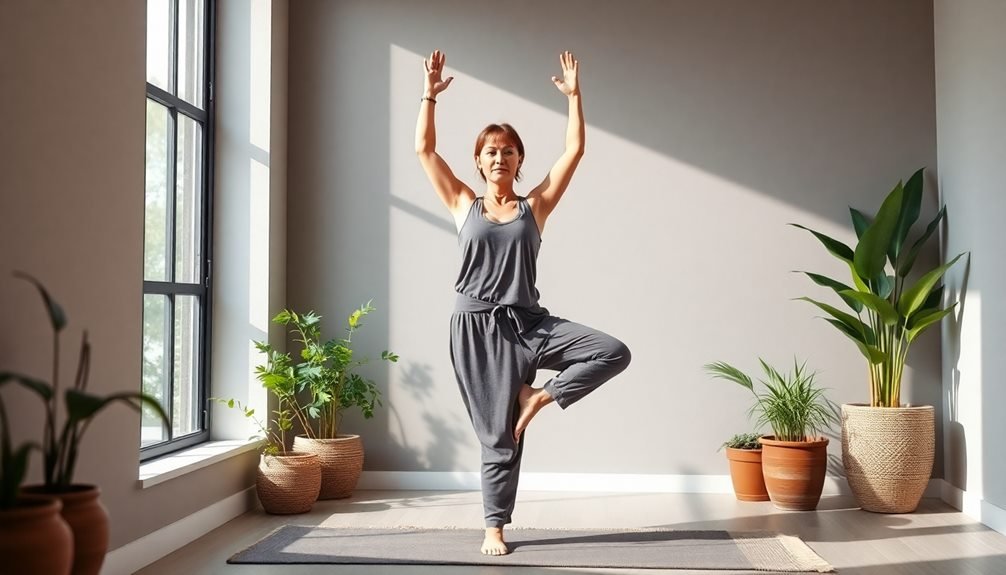
Standing still can be one of the most powerful ways to quiet a racing mind. When you practice balance exercises, your brain must focus on maintaining stability, naturally pushing away anxious thoughts.
You'll find that these gentle movements help ground you both physically and mentally.
Start by standing barefoot on a flat, non-slip surface. Feel your weight distributed evenly across both feet, and let your arms rest comfortably at your sides. As you build confidence, you can progress to more challenging positions that enhance both balance and inner calm.
- Tree Pose: Press one foot against your inner thigh or calf, keeping your pelvis level and breathing steady for 30 seconds.
- Flamingo Stand: Lift one knee to hip height, hold for 15 seconds, then switch legs.
- Heel-to-Toe Walk: Place one foot directly in front of the other, walking slowly in a straight line.
- Single-Leg Clock: Balance on one leg while pointing the other leg in different directions, as if drawing clock numbers.
Remember to keep your movements slow and controlled, focusing on your breath throughout each exercise.
Dancing Away Your Worries
Dancing can transform your stress into joyful movement when you let your body flow freely to your favorite music in the comfort of your own space.
You'll find that moving to the rhythm releases tension while engaging both your mind and muscles in a natural, liberating way.
Whether you choose to sway gently or break into energetic steps, dancing offers a fun escape that lets you express yourself without judgment or rules.
Dance Like Nobody's Watching
A simple solo dance session in your living room can be one of the most liberating forms of stress relief. When you're alone, you can move freely without judgment, letting your body respond naturally to the music.
Put on your favorite playlist, clear some space, and let yourself go with the rhythm. You'll find that dancing releases endorphins while helping you forget about daily pressures.
Dancing at home doesn't require special skills or choreography. You can sway, jump, spin, or simply move your arms – whatever feels right in the moment.
The key is to focus on how the movement makes you feel rather than how you look.
- Move spontaneously without planning your steps – this helps release mental tension and promotes mindfulness
- Express emotions through movement – let your body tell the story your words can't
- Connect with your favorite music in a physical way – creating a mind-body harmony that reduces stress
- Create your own safe space for emotional release – where you can be completely authentic
Start with just five minutes of free movement. You'll likely find yourself wanting to dance longer as your body relaxes and your mood lifts.
Music Moving Your Soul
Why does music have such a powerful effect on our bodies and minds? It's because music triggers the release of dopamine and serotonin, natural mood elevators that reduce stress and anxiety.
When you combine music with gentle movement, you're creating a powerful stress-relief toolkit that you can access anytime.
Start by selecting music that matches your current mood – if you're feeling down, begin with slower songs and gradually shift to more upbeat tunes. You don't need to dance; simply sway, tap your feet, or move your arms to the rhythm. Let the music guide your movements naturally.
Try these simple music-movement exercises: Walk in place to the beat, roll your shoulders while humming along, or stretch your arms overhead following the melody. You can even practice deep breathing by inhaling for four beats and exhaling for four beats.
For maximum benefit, create different playlists for various moods – energizing songs for morning motivation, calming melodies for evening relaxation, and upbeat tunes for stress relief.
Chair-Based Calming Movements

When you're feeling overwhelmed at work or home, simple chair-based movements can help you decompress without leaving your seat. These gentle exercises can release tension, improve circulation, and create a sense of calm in just a few minutes.
Start by sitting tall with your feet flat on the floor and your shoulders relaxed. You'll want to focus on your breath while performing these movements, inhaling deeply through your nose and exhaling slowly through your mouth.
- Shoulder rolls: Roll your shoulders forward five times, then backward five times, feeling the tension melt away from your neck and upper back.
- Seated twists: Place your right hand on your left knee, twist gently to the left while keeping your spine straight, hold for three breaths, then switch sides.
- Ankle circles: Lift one foot slightly off the ground, rotate your ankle clockwise ten times, then counterclockwise, and repeat with the other foot.
- Neck stretches: Drop your right ear toward your right shoulder, hold for 15 seconds, then repeat on the left side, being careful not to force the movement.
Tension Release Through Gentle Rolling
Rolling exercises can help you melt away muscle tension using simple tools you'll find at home, like tennis balls and foam rollers.
You'll want to start with gentle shoulder rolls on a tennis ball against a wall, then progress to lying on the floor with a ball under tense spots in your back.
For deeper muscle release, you can use a foam roller to slowly work through knots and tight areas, applying steady pressure as you roll back and forth.
Floor Rolling For Shoulders
Tension in the shoulders can feel like a heavy burden that weighs you down throughout the day. Floor rolling offers a gentle, effective way to release this built-up stress using just your body weight and a firm surface.
You'll need a yoga mat or carpeted area to practice this tension-relieving technique comfortably.
Lie on your back and slowly roll your shoulders from side to side, allowing your shoulder blades to massage against the floor. Keep your knees bent and feet flat for stability. As you roll, you'll feel the pressure points in your upper back begin to soften and release.
- Roll horizontally across your shoulder blades for 30 seconds to target upper back tension
- Make small circular motions around tight spots to release stubborn knots
- Pause on particularly tense areas, letting your body weight apply gentle pressure
- Breathe deeply while rolling to enhance relaxation and oxygen flow
For best results, practice this exercise for 3-5 minutes daily, especially after long periods of sitting or computer work.
If you experience any sharp pain, stop immediately and consult a healthcare provider.
Back Release With Balls
A tennis ball or massage ball can take your floor relaxation practice to the next level. By placing the ball between your back and the floor, you'll create focused pressure that helps release tight muscles and stubborn knots.
Start by lying on your back and positioning the ball beneath your upper back, just beside your spine. Once you've found a tender spot, breathe deeply and let your body weight sink into the ball. You can make small movements by gently rolling side to side or up and down.
If you find a particularly tight area, pause there for 20-30 seconds while continuing to breathe. Don't rush the process – spend about 2-3 minutes exploring each side of your spine.
For deeper release, you can experiment with different ball sizes. A tennis ball provides moderate pressure, while a lacrosse ball offers more intense pressure for stubborn knots. If you're new to this practice, start with a softer ball.
Remember to avoid rolling directly on your spine, and keep the pressure comfortable. If you experience sharp pain, adjust the ball's position or reduce the pressure.
Self-Massage Using Foam Rollers
Simple foam rollers offer a versatile way to massage tense muscles throughout your body. When you're feeling stressed, these cylindrical tools can help release tension in your back, legs, and shoulders through self-myofascial release.
You'll find foam rolling particularly effective after a long day of sitting at your desk or following intense physical activity.
To maximize the benefits of foam rolling for stress relief, focus on these key practices:
- Roll slowly over each muscle group for 30-60 seconds, paying extra attention to particularly tight areas.
- Maintain steady breathing throughout the process, inhaling deeply through your nose and exhaling through your mouth.
- Apply moderate pressure that feels therapeutic rather than painful, adjusting your body weight as needed.
- Keep your muscles relaxed while rolling to allow for deeper release of tension.
Start with your calves and work your way up to your thighs, hips, and back. If you encounter a particularly tender spot, pause there for 20-30 seconds while taking deep breaths.
You'll notice your muscles gradually softening as circulation improves and tension melts away.
Peaceful Garden Walking Meditation

Walking mindfully through your garden combines gentle movement with nature's calming elements to ease daily stress. You'll find that this practice merges the benefits of light exercise with meditation, helping you release tension while connecting with your surroundings.
To begin, choose a quiet path in your garden where you won't be disturbed. Focus on taking slow, deliberate steps while maintaining awareness of your breathing. As you walk, notice the sensation of your feet touching the ground and the gentle movement of air against your skin.
| Time of Day | Focus Points | Benefits |
|---|---|---|
| Morning | Dewdrops & Bird Songs | Energy Boost |
| Midday | Shadow Patterns | Stress Release |
| Evening | Fading Light | Sleep Preparation |
| Night | Moon & Stars | Deep Reflection |
You don't need to maintain a specific pace – instead, let your body find its natural rhythm. Pay attention to the plants, colors, and textures around you. When your mind wanders, gently bring your focus back to your steps and breathing. Even 10 minutes of garden walking meditation can greatly reduce anxiety and improve your mental clarity.
Stress-Reducing Shoulder and Neck Exercises
When tension builds in your upper body throughout the day, gentle shoulder and neck exercises can provide immediate relief while requiring minimal space or equipment.
You'll find these movements particularly helpful when you're working at a desk or feeling overwhelmed by daily stressors. Focus on slow, controlled motions and remember to breathe deeply throughout each exercise.
- Roll your shoulders forward and backward in slow circles, completing 8-10 rotations in each direction. This helps release trapped tension and improves mobility in your shoulder joints.
- Gently tilt your head toward each shoulder, holding for 15-20 seconds per side. You'll feel a soothing stretch along your neck muscles, which often tighten during stress.
- Interlace your fingers behind your head and slowly draw your chin toward your chest, holding for 20-30 seconds to release upper neck tension.
- Stand tall and squeeze your shoulder blades together for 5 seconds, then release. Repeat 10 times to improve posture and relieve mid-back tightness.
Perform these exercises every few hours, especially when you notice tension building.
They're discrete enough to do at your desk and effective at preventing stress-related muscle stiffness.
Calming Floor Stretches
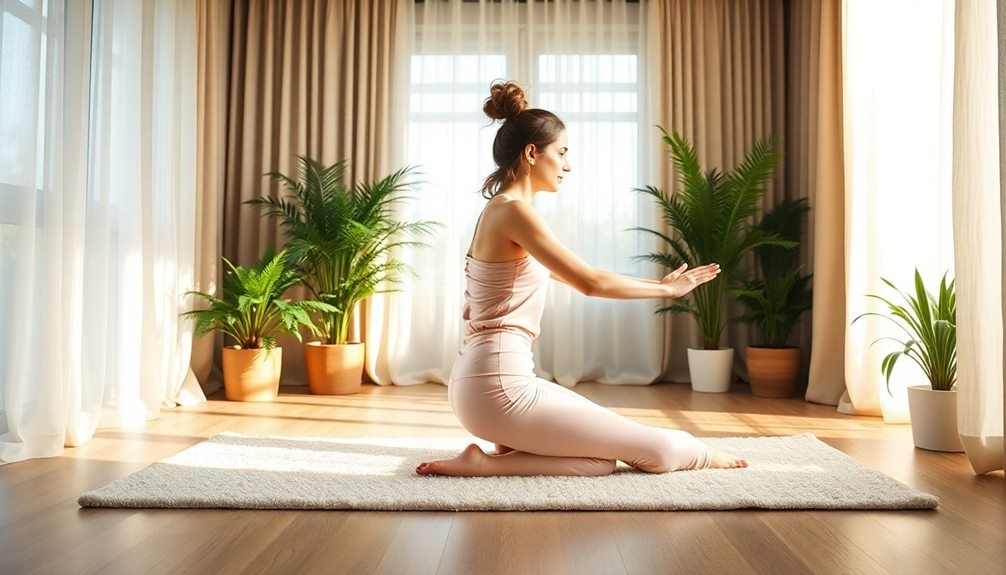
Moving down from standing exercises to the floor opens up a whole new domain of relaxation possibilities. Begin by sitting on a yoga mat or carpet, and take a few deep breaths to center yourself. You'll find that floor-based stretches naturally encourage slower, more mindful movements.
Start with the child's pose: kneel on the floor, sit back on your heels, and extend your arms forward while lowering your chest to the ground. Hold this position for 30 seconds while focusing on your breathing.
Next, try the reclined spinal twist by lying on your back, bringing your knees to your chest, and gently letting them fall to one side while keeping your shoulders grounded.
For a deeper stretch, perform the seated forward fold. Sit with your legs extended, and slowly reach for your toes while maintaining a straight back. Don't force the stretch; you'll feel a gentle pull in your hamstrings and lower back.
Relaxing Hand and Wrist Movements
After long periods of typing or scrolling, your hands and wrists need gentle relief from repetitive stress. These areas often hold tension that can contribute to overall anxiety and physical discomfort.
You'll find that simple hand and wrist movements can help release this built-up strain while promoting relaxation throughout your body.
Start by sitting comfortably in a chair with your feet flat on the floor. Extend your arms in front of you at shoulder height, keeping your shoulders relaxed. You can perform these movements whenever you're feeling tense or every few hours during your workday.
- Make gentle fists, then slowly open your fingers wide, spreading them as far as comfortable. Repeat 10 times.
- Rotate your wrists in circles, first clockwise for 30 seconds, then counterclockwise.
- Stretch your palms facing up, then down, holding each position for 15 seconds.
- Interlace your fingers and gently push your palms away from your body, then toward the ceiling.
Remember to breathe deeply while performing these movements, and stop if you feel any pain or discomfort. These exercises shouldn't strain your muscles but rather provide relief and relaxation.
Frequently Asked Questions
How Long Should I Wait After Eating Before Doing Gentle Stress-Relief Exercises?
You'll want to wait 2-3 hours after a large meal before exercising, but for gentle movements like stretching or light yoga, waiting 30-60 minutes is usually enough to avoid discomfort.
Can These Exercises Help With Nighttime Insomnia?
Yes, you'll find gentle exercises can help with insomnia. Try calming stretches, deep breathing, or light yoga before bed. Just don't overexert yourself – keep movements relaxing to prepare your body for sleep.
Should I Consult My Doctor Before Starting Stress-Relief Exercises?
While most gentle stress-relief exercises are safe, you should talk to your doctor first if you're pregnant, have any injuries, chronic conditions, or take medications that affect your balance or breathing.
What Time of Day Is Most Effective for Stress-Reducing Movements?
You'll get the best stress-relief benefits by exercising in the morning or early evening. Morning workouts boost your mood all day, while evening sessions help release daily tension before bedtime – choose what fits your schedule.
Are There Specific Exercises to Avoid During Anxiety Attacks?
During anxiety attacks, you'll want to avoid high-intensity exercises like HIIT, heavy weightlifting, or sprinting. These can raise your heart rate dramatically and potentially worsen symptoms. Stick to gentle, grounding movements instead.
In Summary
You've now got several gentle ways to ease stress and worry without leaving home. Whether you're stretching on your floor, walking mindfully through your garden, or flowing through simple yoga poses, these exercises will help calm your mind and relax your body. Remember, you don't need intense workouts to find relief – just a few minutes of gentle movement can make a real difference in your daily well-being.
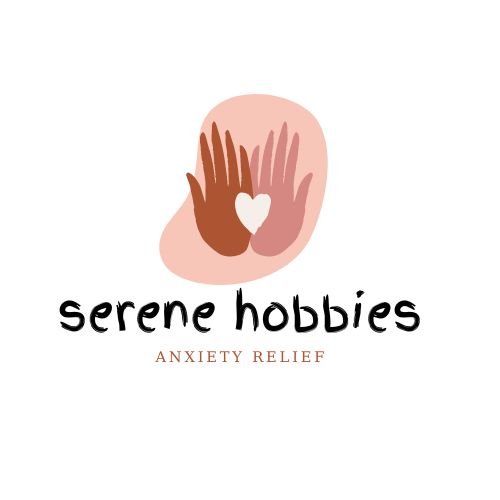
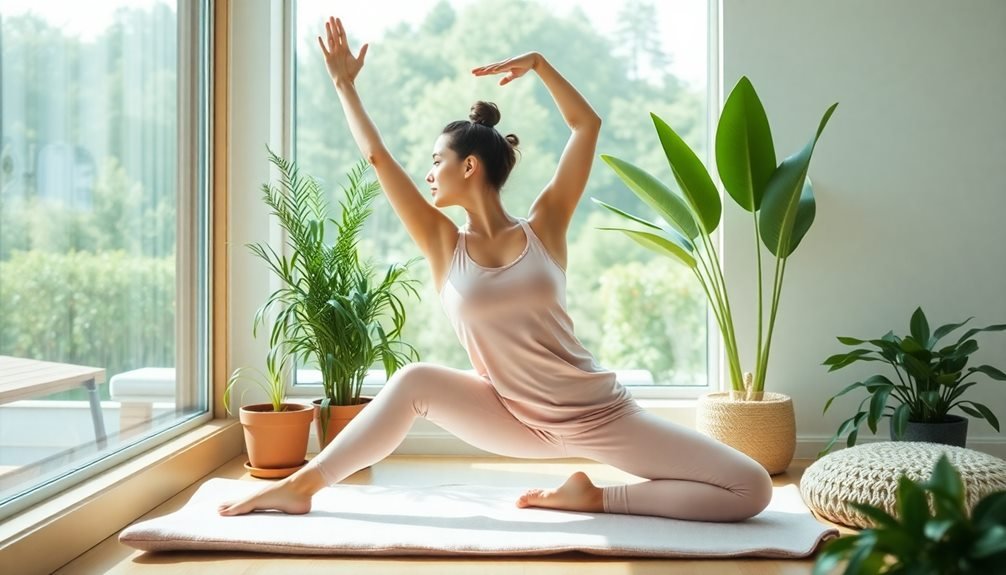
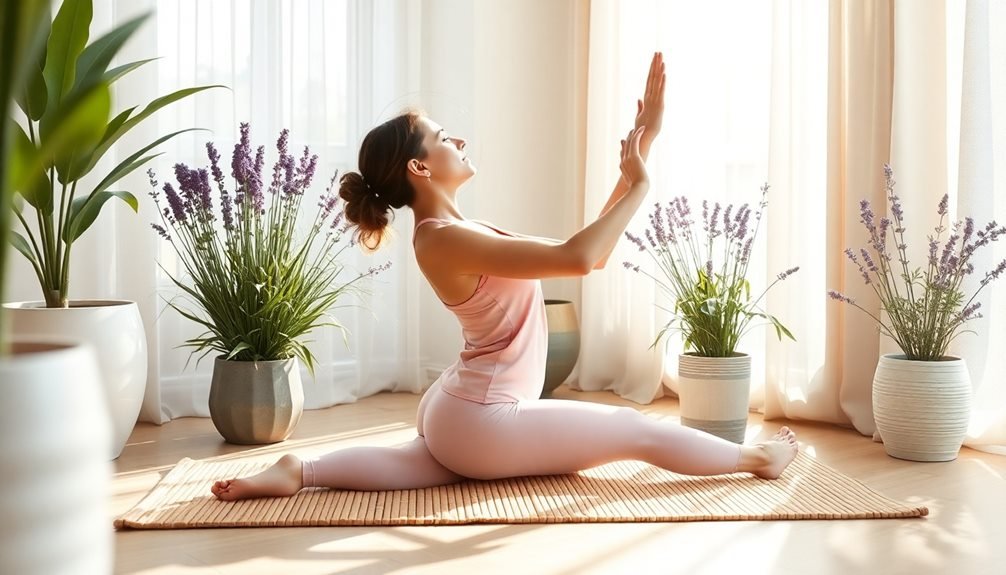
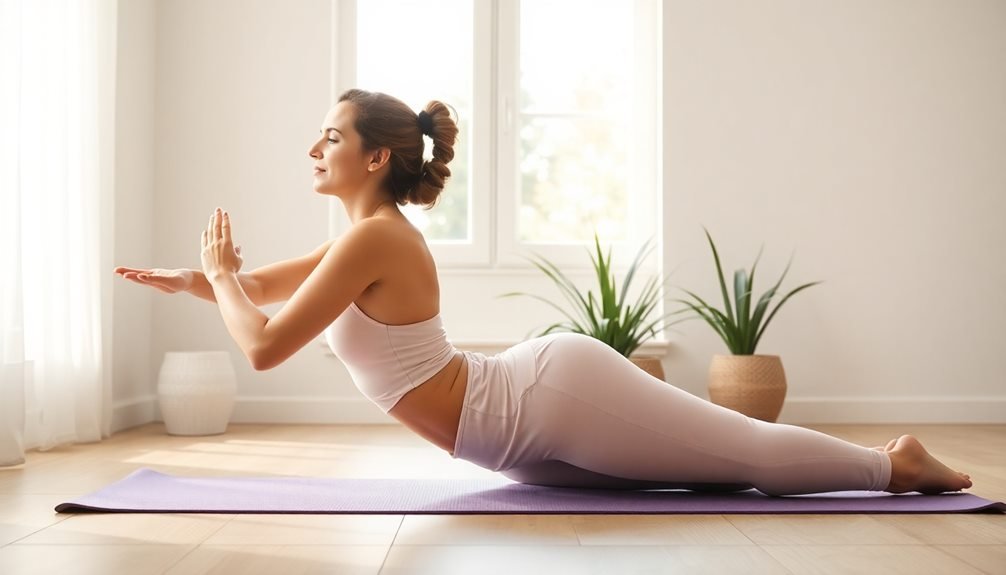
Leave a Reply